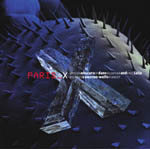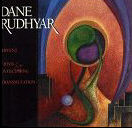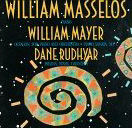 |
| Home | Bio | Art | Music | Literature | Civilization & Culture | Philosophy of Wholeness | Theosophy & Spirituality | Astrology |
|

WHAT IS AN OCTAVE?
D. Rudhyar Eolian Review December 1922 In What is an Octave, Rudhyar continues what he started in the article The Relativity of Our Musical Conceptions. "What counts is the inner attitude of the musical sense within each of us," Rudhyar writes. "This attitude, like the feet of the Chinese women of old, has been molded upon a most rigid conception which had its raison d'être centuries ago but which has become a useless tyrant. Our musical soul has become paralyzed . . . our vision is obscured by the thought-forms made by generations of musicians . . . We are in a shell. Let us break that shell . . . . We shall find then wonders of which we now have no conception; and this shall be our reward for all our lonely struggles against the inertia of the whole world." The Early Musical Writings of Dane Rudhyar are made available for students of musical history and for scholarly research. Rudhyar was concerned that composers, students and scholars should not regard his earliest writings and articles - written while he was still a young man - as his most significant literary contributions to music. The reader is referred to Rudhyar's book The Magic of Tone and the articles The Transforming Power of Tone and When Does Sound Become Music for his mature and fully developed contributions. |
|
Related Articles |
|
Archived Music Articles |
|
|
Also Available Online |
|
» Rudhyar's Integration of Experience and Concepts - Music, from Leyla Raël's The Essential Rudhyar. |
|
Available Offsite |
|
Musical Works |
|
Musical Scores |
|
For scores of Rudhyar's musical works, visit the site of the American Composers Alliance. Musical scores 5 Stanzas and Granites are also available from SheetMusicPlus.com |
|
Also of Interest |

The Music of Rudhyar & Satie PARIS-X Musica Obscura Richard Cameron-Wolfe, Piano. Hear a sound clip 
Piano and String Compositions AVENT, CRISIS & OVERCOMING, TRANSMUTATIONS Marcia Mikulak, Piano and The Kronos Quartet 
An Earlier Recording of Rudhyar's Music Now on CD MASSELOS PLAYS RUDHYAR |
|
Home » Music » Articles on Music As soon as the European or American child comes in contact with music, he hears the word "octave" pronounced. But because the apprehension of this term and the sensorial reality which it expresses and which seems to him self-evident is so familiar to him that he cannot remember the day when it penetrated his brain, the child, now grown up, never thinks for one minute of asking himself this most elementary question: What is an octave? "An octave", he would probably say, "is the interval between two notes which, though having a different pitch, are so similar that they seem almost identical"; or else he might say, "An octave is the interval between the first and the eighth note of any diatonic scale, and by extension, the octave of a note is the eighth step by diatonic succession after this note." These two answers, both correct, are however based upon different points of view. The first point of view is sensorial; the second is theoretical or analytical. In both cases much is assumed and these assumptions are so evident to most of us that we do not even discuss them. They are the axioms of Music. Unfortunately for our innate conservatism, this age of ours is very cruel to axioms. There is indeed a severe epidemic breaking out in the golden city of Axiomtown; so many of its citizens have already been taken away and so many are dying from an incurable consumption! And we, poor human beings, are confronted with the sad duty of carrying all these axioms away to the burning ground. A field of axioms in decomposition is a very ugly sight; better to burn them at once. The problem however is an exceedingly complex one, for all these axioms, musical and otherwise, have many very intimate ties with our most cherished habits and feelings. Yet better to face the difficulty than to avoid it, and so long as we are concerned here with that very old conception of ours, the octave, let us proceed to dissect it. The first definition we gave of an octave was built upon a sensorial notion, a sensorial evidence. We know by experience that among the various notes of our musical scale, from the lowest to the highest audible pitch, there are some which affect us so similarly that we give them the same denomination. In fact we recognize only twelve specific notes and we claim that all others are so affiliated with these as to be practically mere repetitions of them, up or down scale. If we claim this it is apparently because our ears compel us to do so, not for any theoretical reason. Nevertheless, the physicist will tell us that these notes which seem to us so similar are in fact defined by a rapport of frequencies of vibrations, the simplest we can think of, vis., 1:2. So that since C is really the note whose frequency is 64, C', its octave-sound, is the note whose frequency is 64 x 2 = 128; and so on. Multiply the frequency (number of vibrations per second) of a note by 2 and you have the next octave of this note. This seems simple enough, so simple in fact that we do not think of questioning it. Yet if we put the matter differently, if, for instance, we say that the interval of the octave is the most perfectly consonant interval in music, we begin to realize that it may not be so evident as it seemed at first, for we come then across a notion which does not seem to us so stable, the notion of consonance or dissonance. If we ask what a consonant interval is we will be answered somewhat like this: "A consonant interval is an interval so established that the simultaneous production of its two border-notes gives a sensation perfectly satisfactory in itself." But here we unfortunately find that some musicians feel certain chords perfectly satisfactory in themselves, whereas others find these same chords very unsatisfactory and want them to be resolved to what appeals to them as more perfect consonances. Where then shall we find a criterion whereby to judge what is a perfect consonance and what is not? Whenever sensations seem to delude us we fall back upon Science, hoping to find through its intermediacy something partaking of the eternal. Alas! the infallibility of Science has received a terrific blow these last twenty years. Shall we continue to trust Science? Let us however still hold our confidence in Science for a moment and ask of Helmholtz, the great student of musical acoustics, what is dissonance. Helmholtz discovered that all dissonances or discords are due to "unpleasant beats generated by the component notes of this discord, that consonances, on the other hand, are formed by notes which fail to produce beats. What these beats are we may roughly perceive if we strike certain so called dissonant chords upon a piano or a harp and let the sound die away undisturbed. The sound is not homogeneous, but it is as if three or four elements were fighting within it, each of them dominating and being over-powered in turn. Now, Helmholtz showed that the intervals of perfect fourth, fifth and octave are all exempt of beats, that is, are perfect consonances. Then if they are perfect consonances why should we say that the octave is the repetition of a given note, more than the fifth? In other words, why do we select one perfect consonance to form the basis of our scales to the exclusion of the others? We reckon by octaves; why not by fifths? We shall see later that in the chromatic mode the fifth is composed of 7 intervals, exactly as in the diatonic mode the octave is composed of 7 intervals. Let us go further and say that if, from the beginning of our musical education we had been used to taking the fifth as a basis, we should give to the consonance of the fifth exactly the same value as we give today to the octave; we should feel that the higher repetition of a note occurs when the perfect fifth of this note is struck. We say the fifth, but we could say with perhaps still more reason the twelfth. For we see that the ratio of frequency between a note and its higher twelfth is 1 : 3, which ratio is certainly as simple as the ratio of the octave 1: 2. Does it not mean that, after all, when you say C' is the octave of C, (meaning that these 2 notes are in some way identical) you merely conform yourself to a convention, which convention appears self-evident only by virtue of a musical education which took this convention as an axiom? Then if it is a convention, may we not change it or, at least, may it not be in time susceptible to modification as all conventions are when a new civilization is constituted? May it not be that we are in an age when there is in process of formation a new civilization and a new musical system with a new conception of the octave or at least of its musical meaning? Let us now come back to the second definition we gave of an octave in the beginning of this article. If we take any diatonic scale we see that the order of the intervals repeats itself every eighth note; in other words, a diatonic scale or mode is a sort of pattern, a sliding ladder composed of 7 rounds. When the uppermost limit of the ladder is attained you slide it upwards and by this operation you gain a certain new musical space, which is called an octave, every octave being made upon the same pattern. "Octave" comes from the Latin root which means "eight". Therefore the octave of a note is the eighth note below or above it. Occultism and religions lay great stress upon the number 7. It was at all times considered as the number of Life, as the number regulating all cyclic motions, all periodic returns. So we have the 7 days of the week, a week being a short cycle of Manifestation or Life, corresponding to infinitely greater ones as, for instance, the 7 days of Creation as recorded in the Bible. Thus an octave encompasses a complete cycle of Life, or 7 notes, and all octaves of sounds are formed by the repetition of such a cycle at different pitches. This is also very simple. Yet the fusion of all diatonic scales (through the equal temperament) into a chromatic scale already complicates the scheme. In an octave we have then 12 intervals, which is a paradox so far as the etymology of the word "octave" goes. We have heard also of an enharmonic scale, supposedly copied from the Greek, where 22 intervals are included in the octave; also of Hindu modes of as much as 64 intervals to the octave (at least in theory). What does all this mean? It means much we cannot consider in this short article, which aims only at questioning principles blindly followed for centuries, so as to wake us from our musical lethargy. It means above all that there are two ways of counting in a musical progression of intervals. Again all this is only to point out the relativity of our most axiomatic musical conception, the octave (and incidentally of all our musical conceptions), not to try to establish a new system however needed it may be today. All these conceptions are mere conformity to habitual methods which have had a glorious usefulness and have served gallantly in the battle of Art against Matter. Thanks to them, musicians from the thirteenth up to the twentieth century have been able to perform marvels, to create ever-enduring works of art. It does not follow that these conceptions are eternal because the works based upon them are of lasting value. The temples of Egypt are eternal in beauty; but the principles which guided their construction have long since been cast aside for newer and better and more interesting means. Were this not so, we should still be building only Egyptian temples, with painful monotony. Should we continue to use forever the principles of music of a Beethoven because of the splendor of his symphonies, we would be making the same mistake. Our diatonic modes, our chromatic scale can give us no more new material for our needs. Tomorrow it will be worse; each day it is growing worse and worse. Where is the cure? In questioning every one of our musical axioms and refusing to accept them as necessary, as evident. In doing thus we shall open our minds to the understanding of new axioms which, as time shall pass, will become as evident as the old ones they have superseded. We are speaking today of the "octave idea"; but the same things could be said of the concepts of "notes", "temperament", "harmony", etc. Examine all these notions. They are merely aspects. Invert them, and most of the time you may apply them just the same. What counts is the inner attitude of the musical sense within each of us. This attitude, like the feet of the Chinese women of old, has been molded upon a most rigid conception which had its raison d'être centuries ago but which has become a useless tyrant. Our musical soul has become paralyzed, ankylosed. Let us move on, then, and free it so that it may express itself without restraint. But this liberation has to do not only with the rules of musical composition, as is too often believed; it deals also fundamentally with the elements of music, with what we know as "modes", "tonalities", "harmonics and chords", "notation" and also "instruments". Our vision is obscured by the thought-forms made by generations of musicians, and the more beautiful these forms the more heavily they press upon us: our soul cannot speak; it is suffocated. We are in a shell. Let us break that shell, if we are men. We shall find then wonders of which we now have no conception; and this shall be our reward for all our lonely struggles against the inertia of the whole world.  Home | About | Calendar | Ephemeris Charts | Art Gallery | Library | Resources Shop | Links | Rudhyar Archival Project | Help Web design and all data, text and graphics appearing on this site are protected by US and International Copyright and are not to be reproduced, distributed, circulated, offered for sale, or given away, in any form, by any means, electronic or conventional. See Notices for full copyright statement and conditions of use. Web design copyright © 2000-2004 by Michael R. Meyer. All Rights Reserved. |